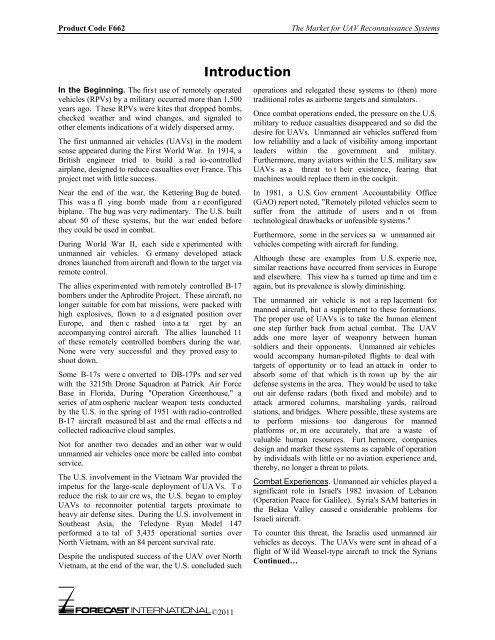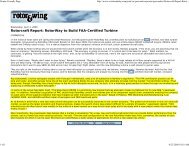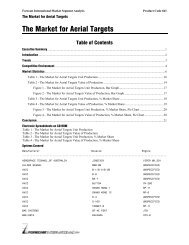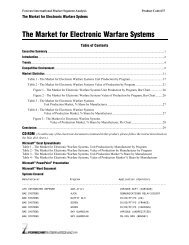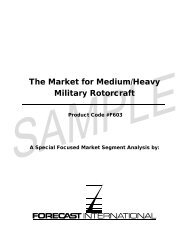The Market for UAV Reconnaissance Systems - Forecast International
The Market for UAV Reconnaissance Systems - Forecast International
The Market for UAV Reconnaissance Systems - Forecast International
Create successful ePaper yourself
Turn your PDF publications into a flip-book with our unique Google optimized e-Paper software.
Product Code F662<br />
<strong>The</strong> <strong>Market</strong> <strong>for</strong> <strong>UAV</strong> <strong>Reconnaissance</strong> <strong>Systems</strong><br />
In the Beginning. <strong>The</strong> first use of remotely operated<br />
vehicles (RPVs) by a military occurred more than 1,500<br />
years ago. <strong>The</strong>se RPVs were kites that dropped bombs,<br />
checked weather and wind changes, and signaled to<br />
other elements indications of a widely dispersed army.<br />
<strong>The</strong> first unmanned air vehicles (<strong>UAV</strong>s) in the modern<br />
sense appeared during the First World War. In 1914, a<br />
British engineer tried to build a rad io-controlled<br />
airplane, designed to reduce casualties over France. This<br />
project met with little success.<br />
Near the end of the war, the Kettering Bug de buted.<br />
This was a fl ying bomb made from a r econfigured<br />
biplane. <strong>The</strong> bug was very rudimentary. <strong>The</strong> U.S. built<br />
about 50 of these systems, but the war ended be<strong>for</strong>e<br />
they could be used in combat.<br />
During World War II, each side e xperimented with<br />
unmanned air vehicles. G ermany developed attack<br />
drones launched from aircraft and flown to the target via<br />
remote control.<br />
<strong>The</strong> allies experimented with remotely controlled B-17<br />
bombers under the Aphrodite Project. <strong>The</strong>se aircraft, no<br />
longer suitable <strong>for</strong> combat missions, were packed with<br />
high explosives, flown to a d esignated position over<br />
Europe, and then c rashed into a ta rget by an<br />
accompanying control aircraft. <strong>The</strong> allies launched 11<br />
of these remotely controlled bombers during the war.<br />
None were very successful and they proved easy to<br />
shoot down.<br />
Some B-17s were c onverted to DB-17Ps and ser ved<br />
with the 3215th Drone Squadron at Patrick Air Force<br />
Base in Florida. During "Operation Greenhouse," a<br />
series of atm ospheric nuclear weapon tests conducted<br />
by the U.S. in the spring of 1951 with radio-controlled<br />
B-17 aircraft measured bl ast and the rmal effects a nd<br />
collected radioactive cloud samples.<br />
Not <strong>for</strong> another two decades and an other war w ould<br />
unmanned air vehicles once more be called into combat<br />
service.<br />
<strong>The</strong> U.S. involvement in the Vietnam War provided the<br />
impetus <strong>for</strong> the large-scale deployment of UA Vs. T o<br />
reduce the risk to air cre ws, the U.S. began to employ<br />
<strong>UAV</strong>s to reconnoiter potential targets proximate to<br />
heavy air defense sites. During the U.S. involvement in<br />
Southeast Asia, the Teledyne Ryan Model 147<br />
per<strong>for</strong>med a to tal of 3,435 operational sorties over<br />
North Vietnam, with an 84 percent survival rate.<br />
Despite the undisputed success of the <strong>UAV</strong> over North<br />
Vietnam, at the end of the war, the U.S. concluded such<br />
Introduction<br />
operations and relegated these systems to (then) more<br />
traditional roles as airborne targets and simulators.<br />
Once combat operations ended, the pressure on the U.S.<br />
military to reduce casualties disappeared and so did the<br />
desire <strong>for</strong> <strong>UAV</strong>s. Unmanned air vehicles suffered from<br />
low reliability and a lack of visibility among important<br />
leaders within the government and military.<br />
Furthermore, many aviators within the U.S. military saw<br />
<strong>UAV</strong>s as a threat to t heir existence, fearing that<br />
machines would replace them in the cockpit.<br />
In 1981, a U.S. Gov ernment Accountability Office<br />
(GAO) report noted, "Remotely piloted vehicles seem to<br />
suffer from the attitude of users and n ot from<br />
technological drawbacks or unfeasible systems."<br />
Furthermore, some in the services sa w unmanned air<br />
vehicles competing with aircraft <strong>for</strong> funding.<br />
Although these are examples from U.S. experie nce,<br />
similar reactions have occurred from services in Europe<br />
and elsewhere. This view ha s turned up time and tim e<br />
again, but its prevalence is slowly diminishing.<br />
<strong>The</strong> unmanned air vehicle is not a rep lacement <strong>for</strong><br />
manned aircraft, but a supplement to these <strong>for</strong>mations.<br />
<strong>The</strong> proper use of <strong>UAV</strong>s is to take the human element<br />
one step further back from actual combat. <strong>The</strong> <strong>UAV</strong><br />
adds one more layer of weaponry between human<br />
soldiers and their opponents. Unmanned air vehicles<br />
would accompany human-piloted flights to deal with<br />
targets of opportunity or to lead an attack in order to<br />
absorb some of that which is th rown up by the air<br />
defense systems in the area. <strong>The</strong>y would be used to take<br />
out air defense radars (both fixed and mobile) and to<br />
attack armored columns, marshaling yards, railroad<br />
stations, and bridges. Where possible, these systems are<br />
to per<strong>for</strong>m missions too dangerous <strong>for</strong> manned<br />
plat<strong>for</strong>ms or, m ore accurately, that are a waste of<br />
valuable human resources. Furt hermore, companies<br />
design and market these systems as capable of operation<br />
by individuals with little or no aviation experience and,<br />
thereby, no longer a threat to pilots.<br />
Combat Experiences. Unmanned air vehicles played a<br />
significant role in Israel's 1982 invasion of Lebanon<br />
(Operation Peace <strong>for</strong> Galilee). Syria's SAM batteries in<br />
the Bekaa Valley caused c onsiderable problems <strong>for</strong><br />
Israeli aircraft.<br />
To counter this threat, the Israelis used unmanned air<br />
vehicles as decoys. <strong>The</strong> <strong>UAV</strong>s were sent in ahead of a<br />
flight of Wild Weasel-type aircraft to trick the Syrians<br />
Continued…<br />
©2011


